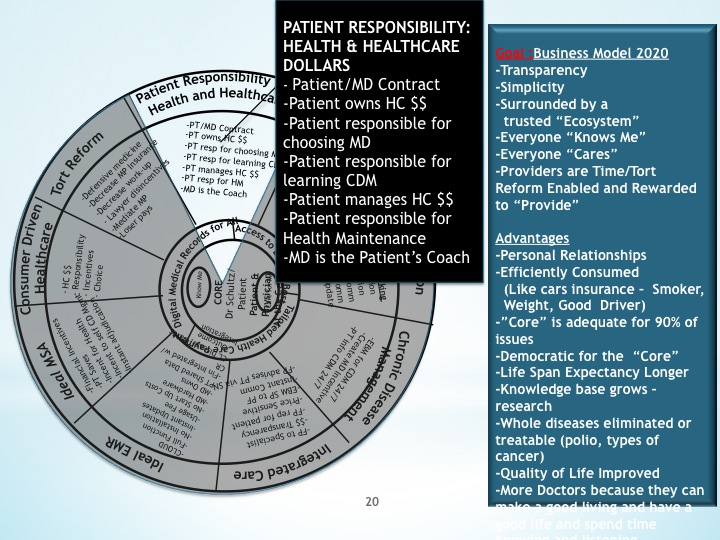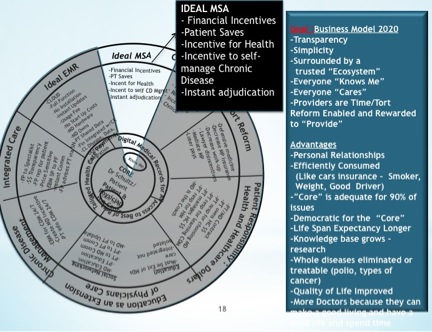Combining My “Ideal Medical Savings Accounts” And “Reference Pricing”
Stanley Feld M.D.,FACP,MACE
President Obama has declared over
and over again that no one has presented ideas better than Obamacare.
I believe he has no interest in
listening to anyone.
President Obama fooled many people
with his intentions, including me. The traditional media is finally catching on
to him.
All of the stakeholders are at fault
in causing the dysfunctional healthcare system. The dysfunction is the result
of all the stakeholders trying to adjust to ever changing government regulations
during the last 48 years
Obamacare is making that dysfunction
worse.
A consumer driven healthcare system
is the only way to Repair the Healthcare System.
I think President Obama wants the
healthcare system to fail. He wants to prove that the free market cannot
succeed.
He is deaf to the fact that the
healthcare system is not a very free market system. Government regulations, tax favors, and tax
barriers over the years have interfered with the free market in healthcare.
The Affordable Care Act (Obamacare) intends to transform the
health-care system, extend coverage, reduce costs and increase quality—all
without asking anything of the patients.
Consumers will pay
with higher taxes, of course, but otherwise will face no incentives to make
wise choices, compare price with performance or shop for value.
Doctors, hospitals,
insurers and, most of all, the government will do that for them, which is
hardly reassuring.
This reflects what I
call the "impossibility theorem" in health care. The impossibility theorem maintains that patients cannot
make good choices, but, rather, must be dependent on the well-intentioned
decisions of others.
Policy makers believe this theorem by
definition. But, just to make sure, they have structured the health-insurance
system to ensure that patients are never asked or allowed to make
price-conscious choices.
The arrangement underlies the innumerable
rules, subsidies, entitlements, mandates and prohibitions that collectively
make health care the least efficient part of the economy.
ObamaCare makes it worse.
I do not think consumers believe or trust President
Obama. Consumers certainly do not believe “the impossibility theorem.”
Consumers are ready for some common sense healthcare
policy. They just do not know what to do.
Consumers must be given incentives to control
healthcare costs. This can be done in several ways.
Consumers must be put in charge of their health and
healthcare dollars.
The
central pillar of effective healthcare reform is the creation of a system that
forces the healthcare insurance industry to be competitive and answerable to
consumers.
Consumers
must have incentives to control costs. This, in turn, would force hospital
systems and physicians to be competitive and reduce costs.
The government’s
role should be to empower consumers to have greater control over their
healthcare decisions, their health, their healthcare dollars and their
healthcare coverage.
The
government should teach consumers to make educated choices in their healthcare
decision-making.
Price
transparency of healthcare fees and parity of tax deductions between the individual
insurance market and the group healthcare insurance market is essential.
It is fool
hearty to assume that the redistribution of wealth, raising taxes by means
testing and price fixing will solve the problems in the healthcare system.
“Why on earth would we want a system,
especially with something as personal as health care, where all of these free market
signals are lost, and insurers responding to regulators, not to us?”
Entitlement programs have never produced free market
efficiencies. Entitlements have created unsustainable, unfunded liabilities.
Leadership must face this problem not add to the
problem.
In the past seventy years medical advances through
research and technology have improved medical care and medical outcomes. Medical
advance has focused on fixing diseases after they have occurred.
Consumers are the only ones that can prevent most
medical and surgical problems.
They can prevent most chronic diseases such as Type 2
Diabetes, heart disease, lung disease and others.
Consumers are also the only ones that can prevent the
costly complications of a chronic disease.
A healthcare system must be constructed to incentivize
consumers to be responsible for their health and healthcare dollars.
Eighty percent of the healthcare dollars spend on
diabetes care is spent treating the complications of diabetes.
A healthcare system must be developed to align all of
the primary and secondary stakeholders’ incentives.
Only consumers can align all the stakeholders’
incentives.
Government control of the healthcare system cannot and
has not aligned those incentives.
Right now we are seeing bureaucracies making a $634
million dollar error with healthcare.gov. This is only the tip of the iceberg
for the problems in store for Obamacare.
The solution is not a single party payer. We will have
the same problems or worse because of the expansion of Medicaid. President
Obama’s hope was the cost of increasing Medicaid would be shifted to the
states.
The increase in cost will increase the federal deficit
and unfunded liabilities.
A healthcare system must be constructed to empower
consumers. I have written in detail about my ideal medical savings accounts.
I have pointed out that it can be very democratic.
Everyone can be insured while decreasing the costs.
The ideal medical
saving accounts will motivate and empower consumers to save money by staying
healthy, staying out of the emergency rooms, and decrease over testing and over
treatment.
Consumers would be
motivated to shop for the top value and quality care.
The government would
require providers to publish the discounted prices paid by the government and
the healthcare insurance companies to all consumers.
My ideal medical
saving account would incentivize consumers to save money. It would be the
responsibility of consumers to shop for the best price at the best quality.
Consumers would
carry their medical records digitally on a flash drive or on their smart phone
to avoid over testing. They would reap the financial benefits of these cost savings.
Consumers, after
the initial $6,000 dollars was spent, would receive first dollar healthcare coverage.
I have always been
satisfied with the front-end incentives. I have never been satisfied with the
catastrophic coverage. It does not provide financial incentive for consumers to
save.
I finally figured
it out. Consumers would continue to receive first dollar coverage if they spent
over the initial $6,000 after the initial stakeholders.
The discounted
hospital, surgical and medical device costs would be published along with
outcomes.
Discounted prices
for services could also vary for the same services. The outcomes could be the
same.
A hospital system
with better outcomes should receive more. If the hospital system negotiates a
higher fee than another hospital system but has the same outcome the consumer
should be liable for the difference.
In this way the decision for choosing the
provider is in the hands of the consumer.
Combining my ideal medical saving account and “reference
pricing” will incentivize consumers to be in control of their healthcare costs
and their health and healthcare dollars.
Consumers should receive pretax dollar treatment for
all expenditures.
Consumers will then shop for price and quality to
their financial advantage. This will
incentivize providers to compete on both price and quality.
The Oklahoma Surgical Center has forced local
hospitals to do just that. The Surgical Centers’ online prices were one half to one
fifth the prices of the local hospital. The hospital centers are now starting to
compete on price and quality.
The combination
of the ideal medical saving accounts and reference pricing will incentivize
providers to be aligned with consumers’ goals.
The opinions expressed in the blog “Repairing The Healthcare System” are, mine and mine alone
Please have a friend subscribe

